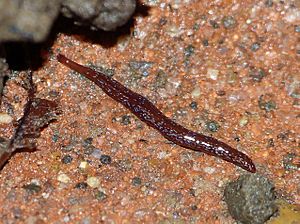Marionfyfea adventor facts for kids
Quick facts for kids Marionfyfea adventor |
|
|---|---|
 |
|
| Marionfyfea adventor in a garden in France | |
| Scientific classification | |
| Kingdom: | |
| Phylum: | |
| Class: |
Rhabditophora
|
| Order: | |
| Suborder: |
Continenticola
|
| Family: |
Geoplanidae
|
| Subfamily: |
Rhynchodeminae
|
| Tribe: |
Anzoplanini
|
| Genus: | |
| Species: |
M. adventor
|
| Binomial name | |
| Marionfyfea adventor Jones & Sluys, 2016
|
|
Marionfyfea adventor is a type of land flatworm that was first discovered in 2016. Scientists found it in countries like the United Kingdom, the Netherlands, and France. This flatworm belongs to a group called Marionfyfea. Other flatworms in this group are usually found only on small islands near New Zealand. Because of this, scientists think M. adventor probably traveled to Europe from those faraway islands.
Contents
Discovering the Marionfyfea adventor Flatworm
This section describes what the Marionfyfea adventor flatworm looks like.
Physical Appearance
Marionfyfea adventor is a fairly small land flatworm. It is about 1 centimeter (0.4 inches) long and 1 millimeter (0.04 inches) wide. When it pulls its body in, it becomes plump. Then it is about 5 millimeters (0.2 inches) long and 1.5 millimeters (0.06 inches) wide.
Its top and sides have patches of light and dark brown colors. It also has tiny blue spots that look shimmery or rainbow-like. The bottom part, called the "creeping sole," is a plain lighter brown. This part is about 40% of the flatworm's body width.
Eyes of the Flatworm
This flatworm has many eyes. It has between 70 and 80 eyes in total. These eyes help it sense light and movement in its environment.
Where Marionfyfea adventor Lives
This flatworm has been found in many different places.
Known Locations
Marionfyfea adventor has been seen in several European countries. These include the United Kingdom, the Netherlands, France, Germany, Denmark, and Ireland. The places where it has been found are spread out.
How Marionfyfea adventor Arrived in Europe
Scientists believe this flatworm is an "introduced species." This means it did not originally live in Europe.
Traveling to New Homes
In 2016, scientists Hugh Jones and Ronald Sluys studied this flatworm. They believe M. adventor originally came from the subantarctic islands or main islands of New Zealand. They think the most likely way it came to Europe was through the international plant trade. This is when plants are bought and sold between different countries.
The fact that it is found in many different places suggests something important. It might have been living in Europe for a long time already.

